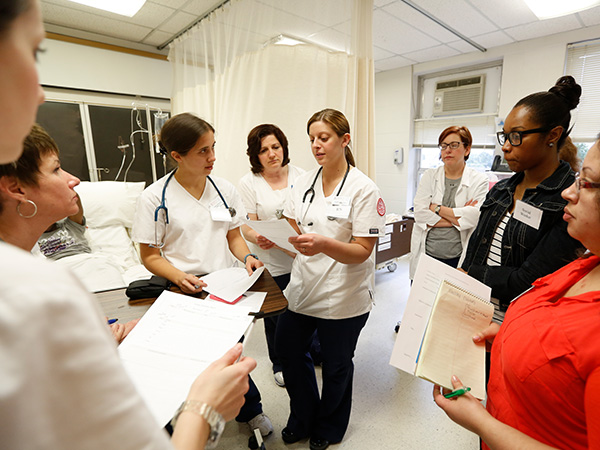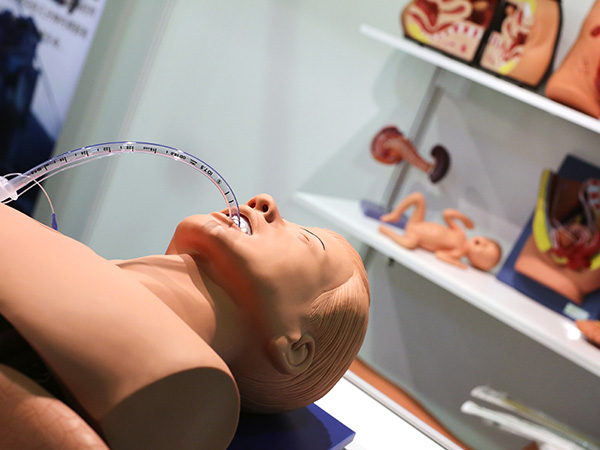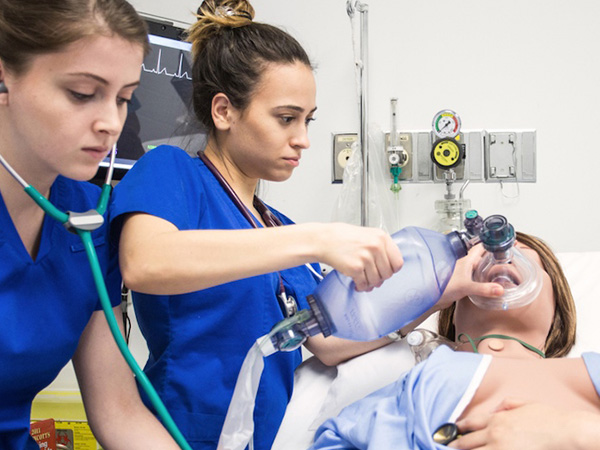Recruiting and preparing the next generation of nurses is a crucial component of improving worldwide healthcare delivery systems and aggregate patient outcomes. To make institutions more attractive to high-caliber nursing school applicants and better prepare current students for the profession, many nursing schools employ innovative training programs and next generation technologies. Because of this continuous effort to recruit, retain, and comprehensively train students, nursing simulation labs have become an invaluable resource.
Simulation labs are particularly attractive to nursing students because they help bridge the gap between skills trainers, theory coursework, and clinical rotations. These simulated environments provide real-world nursing practice where learners can apply recently obtained clinical skills in a consequence-free atmosphere well-equipped for collaboration and instruction.
However, in an ultra-competitive healthcare education landscape, simply keeping a simulation program in line with current accreditation standards and operating on a status-quo basis is not enough to attract the highest quality students.
Read on to discover the key attributes many of the most successful nursing simulation labs share, plus how to implement these strategies at your institution.
Clearly Defined Goals
No matter how simple or ambitious your simulation education plan may be, developing one with well-defined goals is imperative. Successful nursing simulation labs have clear objectives in mind so they can more accurately determine the resources they need to meet their targets.
Focusing on a few core questions will help shape and identify these key objectives. To begin, you should ask what your learning objectives are, as well determine what skills your learners need to develop. For example, if there is a specific emphasis on certain hands-on clinical skills such as phlebotomy and IV placement, those need to be distinctly identified in your education plan.
Secondly, identify which core competencies are addressed in your nursing simulation program. By connecting competency to your simulation curriculum, you can proactively plan for a modular instructional approach that specifically addresses individual competencies. It also lays the groundwork for both the learner and the instructor to maintain progress accountability.
A Sustainability Plan
Hopefully, the program goals you’ve set reach beyond the current budgetary calendar. With long-term targets in place, you also need a sustainability plan to support that vision. A straightforward, future-facing plan provides a clear guide for your nursing simulation lab as you identify what resources are necessary to sustain your program, encourage the development of partnerships, and support intradepartmental collaboration.
Planning for sustainability helps highlight your program’s progress and demonstrates the necessary steps you need to take to ensure long-term success. This type of road map is helpful, especially if your initial funding was grant-supported and you need to showcase the ongoing development of your simulation program.
Installing a sustainability plan will provide current and future staff with a handbook on maintaining your simulation training program, not just for the current fiscal year but also into the future.
Recruitment and Retention of Staff
Many factors figure into a nursing student’s selection of a school, with cost, schedule flexibility, and convenience of the location being among the primary concerns. But today’s applicants also want to ensure they receive the highest quality education.
Building and maintaining a quality nursing simulation lab and operating an excellent program will go a long way toward satisfying this requirement for recruiting instructors and administrators. Once you’ve established your staff, you must remain vigilant in your retention policies. Securing relevant funding support for salaries, creating formal mentorships networks, promoting cross-disciplinary engagement, and addressing career-life issues in meaningful ways are all vital steps to retaining your program’s most valuable resource for the long term.
Hiring and retaining innovative nurse educators will ensure students stay on the cutting edge of patient care delivery in both theory and practice, and meet and exceed their educational competencies to reinforce preparedness for real-world medical challenges.

Thought Out Locations
World-class instructors are a must to facilitate thriving nursing simulation labs, but the importance of the physical environment your training gets conducted in cannot be overlooked. In the end, you may not have the luxury of selecting the exact location of your nursing simulation lab. However, you should still remember to keep these core considerations in mind – even if you’re starting the process of designing a new nursing simulation lab or making changes to your existing facilities, keep in mind:
Utilize your allotted space appropriately
Placement of your simulation, control, and debriefing rooms all have unique factors that contribute to their success. Access to the unique positioning of the wiring for individual technology components must be considered for each type of room separately as each has disparate functions.
Don’t forget about the audio capture
Even the highest definition video cannot make up for poor audio quality. If you can’t hear what your learners are doing in the simulation space, you only get half of the story, which makes debriefs more frustrating and less impactful. You must ensure your simulation rooms aren’t contaminated with external noise or rendered ineffectual by poor microphone placement.
Don’t forget about storage
Ideally, you’ll be maximizing your return on investment in your nursing simulation lab by using it cross-departmentally, covering a range of learning scenarios. Unfortunately, this kind of mixed-use will necessitate additional equipment that will apply in some simulations but not others. Having adequate storage will allow students to have visual access to only the tools and equipment they need for their specific simulation lab nursing scenarios, keeping unused items out of the way.

Maintaining the Appropriate Amount of Simulation Realism
A highly realistic nursing simulation lab experience enables newly trained nurses to progress from simulated training scenarios to traditional medical environments. And threading the realism needle for students transitioning from didactic learning to putting their clinical skills into action in simulation scenarios can be tricky.
Provide too little realism, and skills that learners need may not be transferable to real-world practice. Offer too much realism, and your operations costs rise exponentially while the complexity of execution may counteract efficiency and drive learning performance down.
The following questions may help you focus on the appropriate realism level for your program:
- What are the most important skills and competencies addressed in your simulation lab nursing scenarios?
- What are your budgetary constraints, and are they compatible with any future growth plans?
- Will all training be done in person or are you working virtual and hybrid-learning constructs into your curriculum?
- How will standardized patients and manikins be utilized within your program?
By answering some of these questions, you can tailor simulation realism to meet your instructional goals and provide students with the ideal amount of “immersion” within the training experience.

Availability of Virtual Training
Increased competition to recruit and retain nursing students also accelerates students’ expectations in regard to a program’s diversity of offerings. Current and future students are searching for programs offering flexible and convenient instructional modalities in addition to traditional in-person learning. Many industries have pivoted to providing core tenets of their offerings online to satisfy this expectation, and healthcare education should be no exception.
To accommodate students’ growing demand for online education, consider augmenting your nursing simulation lab with a virtual solution. Virtual, on-demand simulation training allows educators to conduct training sessions anytime, anywhere. At the minimum, you should be able to deploy a virtual platform with built-in video conferencing functionality that can fully support your nursing simulation training workflows.
Longitudinal Competency Tracking
A nurse’s skill and confidence levels are crucial factors in producing better patient outcomes. Because advances in healthcare move fast, healthcare educators need to conduct thorough evaluations that are comprehensive, user-friendly, and transparent to both faculty and students to keep up with changes in medical and healthcare policies.
Successful nursing simulation labs incorporate innovative competency tracking systems that assess curriculum, manage clinical training, and track learner progression throughout their entire education lifecycle. This holistic approach to assessment empowers administrators and faculty to analyze learner performance to pinpoint any training gaps your simulation program may have or identify struggling learners and step in to provide remediation.
Longitudinal simulation-based data is not only useful for improving your simulation training curriculum and enhancing student performance but can be a critical information source for accreditation and budgeting purposes.
Enhancing Student Outcomes in Your Nursing Simulation Lab
Running a successful nursing simulation lab depends on a broad range of elements, each contributing key components for a well-rounded training philosophy. With clear-cut goals, an eye on sustainability, superior staff retention policies, and well-thought-out facility and technology planning, simulation programs help improve learning performance and better prepare future nurses for real-life decision-making.
The most valuable artifact of simulation in nursing education is that it helps your institutional administrators and faculty more comprehensively equip learners for real-world clinical practice, which ultimately leads to more effective patient care.


